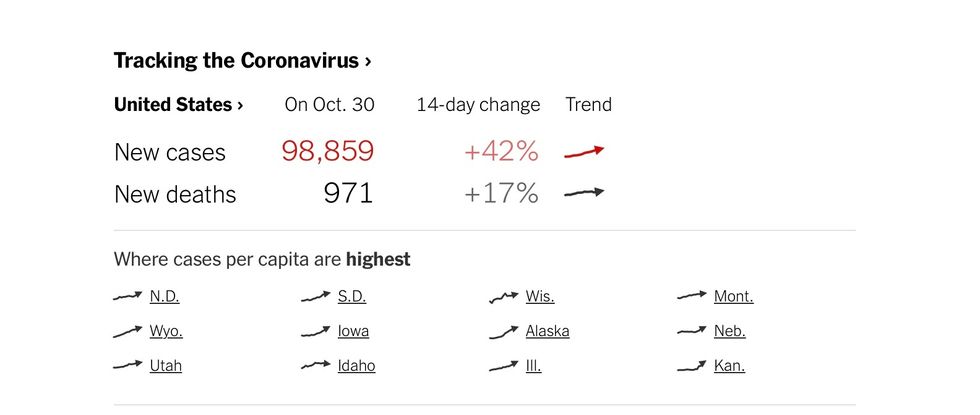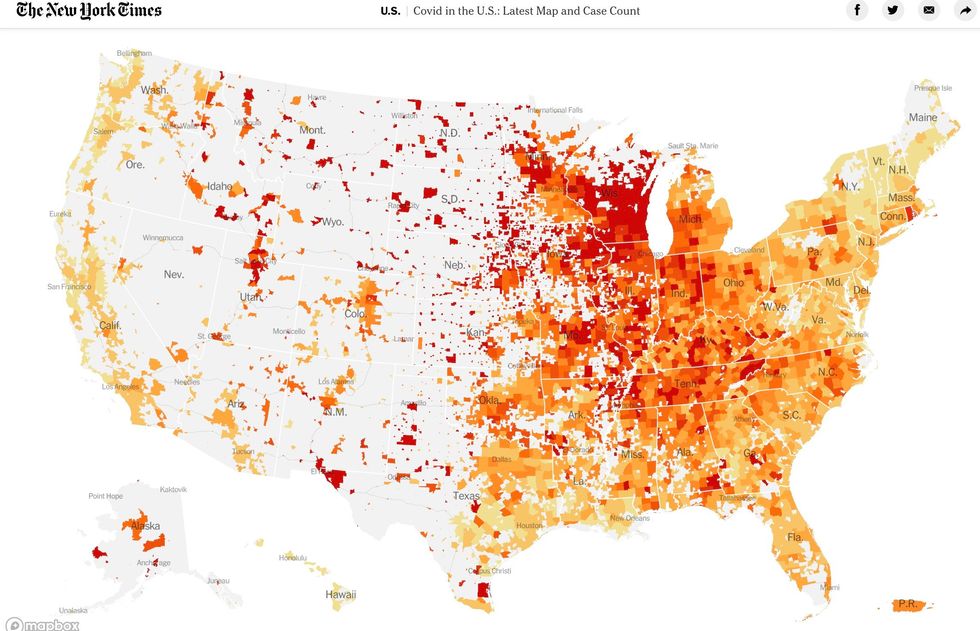The United States recorded over 99,000 coronavirus cases on Friday, a level reached for the first time since the pandemic began. After eight months battling the virus, nearly two dozen states are reporting their worst weeks for new cases — and none are recording improvements.
Sixteen states reported single-day records for new cases on Friday: Iowa, Kentucky, Wyoming, North Dakota, South Dakota, Utah, Montana, Illinois, Minnesota, Pennsylvania, West Virginia, Oregon, Kansas, Ohio, Colorado and Maine. And three states hit record deaths: Tennessee, Montana and New Mexico.
The outbreaks look different across the country, with states close in proximity sharing phases of the pandemic. Some, like North Dakota and South Dakota, have endured an extremely high number of cases for weeks — the Dakotas are ranked first and second nationally in recent cases per capita. Officials in North Dakota reported a single-day record Friday for the second day in a row. Nearby Montana and Wyoming also hit single-day records for new cases on Friday.
In the Midwest, Illinois, Ohio and Michigan are experiencing swift, alarming rises in case counts. In Illinois, new cases have increased nearly 70 percent in two weeks, with more than 8,010 new cases on Friday, the second single-day record in a row. Ohio reported 3,845 new cases on Friday, the second single-day record in a row. And Michigan has been averaging more than 3,000 cases per day for the past week — an increase of 88 percent from the average two weeks ago.
And the numbers in states like New Hampshire and Maine remain low, but they are backsliding after long periods of stability. Maine in particular has seen three of the four highest single day totals come this week. Rhode Island limited gatherings to 10 people Friday, after a single high school party in the state led to five positive coronavirus cases and 1,000 people in quarantine.
In Utah, where officials last week issued urgent pleas saying they were planning on opening a field hospital, the state reported 2,260 new cases on Friday, a single-day record. Officials deployed a statewide wireless emergency alert because of the rising case counts on Friday, which read: "Almost every county is a high transmission area. Hospitals are nearly overwhelmed."
Hospitalizations and deaths are also trending upward. Across the nation, more than 46,600 people were hospitalized with the virus on Friday, an increase of about 25 percent over the last two weeks, according to the COVID Tracking Project. The country has averaged just over 800 deaths a day over the last week, up from about 700 a month ago.
On Thursday, more than 1,000 Americans died from Covid-19, an increase of 16 percent from two weeks ago. On the same day, the president's son Donald Trump Jr. sought to downplay the severity of the virus, saying that deaths were "almost nothing" in an appearance on Fox News. In total, more than 229,000 Americans have died from the virus, and more than 970 deaths were reported on Friday.
Cities, too, are issuing warnings as cases tick upward. San Francisco Mayor London Breed announced that the city was temporarily pausing the reopening of certain businesses and activities that were scheduled to resume on Tuesday — restaurants will now stay at 25 percent capacity for indoor dining, and indoor pools and locker rooms at gyms will remain closed, among other changes.
Yet experts warn that the variability may simply end with the virus resurging to high levels across the entire country.
"We're going to see much less evidence of regionalization of this virus over the course of the next several weeks," said Dr. Michael Osterholm, an infectious diseases expert at the University of Minnesota. "I think this is going to ultimately end up being an entire country on fire."
This week, the United States reached its worst week for virus cases, with more than 559,000 new infections reported in the seven-day period that ended on Friday. The country also crossed the threshold of nine million infections since the pandemic started. The virus still has the potential to infect millions more, since the country has not neared herd immunity, Dr. Osterholm said. "The virus is going to keep coming back," he said.
The combination of pandemic fatigue, more indoor transmission of the virus during the winter months, and the reopening of businesses and activities, such as sports, could mean that states that aren't seeing an increase in infections may see one soon. "I don't see any location in the United States that's going to be free of a major increase in cases," he said. "And I think we're just getting started."
When high case counts emerge in communities, the spillover to surrounding populations is rapid, Dr. Osterholm said. The situation, he noted, can be likened to a "coronavirus forest fire."
"A forest fire never burns evenly everywhere," he said. "But if the embers are still around, they ignite again and then that area does burn eventually. And I think that that's what we're seeing here."
— Giulia McDonnell Nieto del Rio, Mitch Smith and Rebecca Halleck, New York Times, October 30,2020

###
October 31, 2020
Voices4America Post Script. Dueling America -drugged up Donald Jr. says the deaths are “almost nothing.” Joe: “Let me be clear: Anyone who is responsible for plunging and ensnaring America in this crisis — anyone who could do so without an ounce of shame or a shred of empathy — should not be president.”
You make the decision. A President who lies, does nothing and feels nothing vs. A President who cares about you and your family and will listen to the science and take action. #TrumpVirus #Vote #BlueUpandDown #BidenHarris2020 #EndOurNationalNightmare
Here’s the national map.


